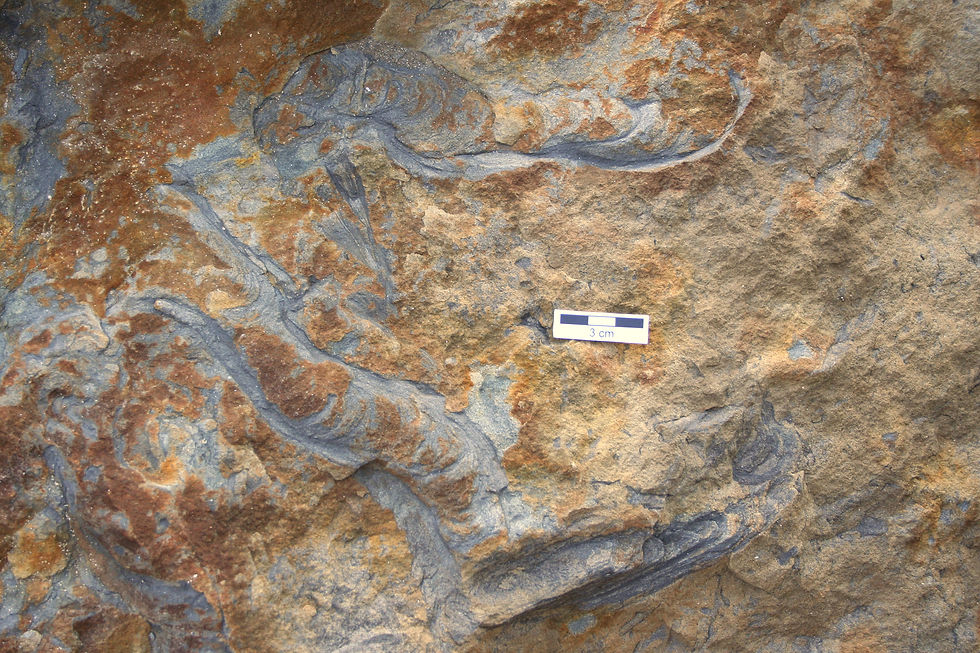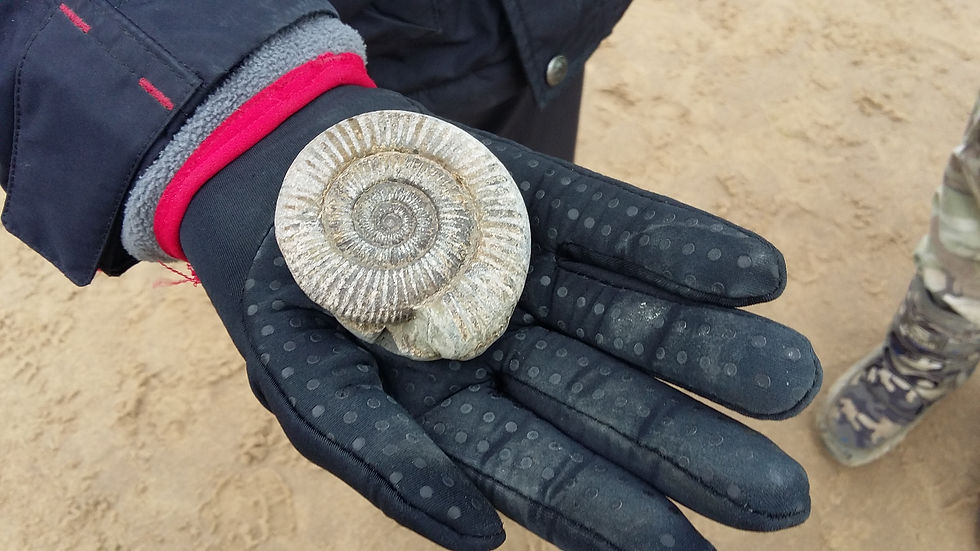Discover the North Yorkshire and Cleveland Heritage Coast and Explore its Fossils and Dinosaurs
- Wayne Munday
- Jul 18
- 4 min read
Updated: Sep 11
Sip back and discover the North Yorkshire and Cleveland Heritage Coast and explore its geodiversity, fossils and dinosaurs. This is one of Britain’s most remarkable landscapes for fossil hunting and is designated as a Heritage Coast and Site of Special Scientific Interest (SSSI). Often referred to as Yorkshire’s Jurassic Coast or the Yorkshire Dinosaur Coast, this 36-mile stretch from Saltburn-by-the-Sea to Filey Brigg along the eastern edge of the North York Moors National Park showcases an extraordinary geodiversity. Much like the more famous Jurassic Coast of Devon and Dorset, it presents a near continuous geological record spanning over 185 million years of the Mesozoic Era. This coastline lies within the Cleveland Basin a structurally complex depression flanked by uplifted areas formed by localised crustal stretching, faulting and deformation of an extensional tectonic regime. The Cleveland Basin accumulated thick sequences of marine and river sediments during the Toarcian, Aalenian, and Bajocian stages of the Early to Middle Jurassic epoch between 184.2 - 168.2 million years ago. At that time, the region experienced a warm tropical climate and widespread flooding by a shallow epeiric sea into which rivers and deltas also discharged their sediment. Today, this dramatic coastal landscape offers unparalleled access to fossiliferous rock, with towering cliffs from the Staithes in the north to the iconic headlands of Flamborough in the south exposing marine and terrestrial fossils, including ammonites, marine reptiles, plants, and a diverse ichnofauna. Particularly significant are the Saltwick, Cloughton, and Scalby formations, which have yielded not only fragmentary dinosaur remains but also an abundance of dinosaur trackways and footprints making the Cleveland Basin a true megatracksite for species of theropods, sauropods, ornithopods, and stegosaurs. The North Yorkshire and Cleveland Heritage Coast is an essential destination to visit and explore Britain’s deep-time heritage and enjoy safe and responsible fossil hunting along its shores.

The Cleveland Basin of northeast England is a geologically important sedimentary basin formed during the Jurassic Period. Its structural evolution was influenced by an underlying layer of Late Permian Zechstein evaporites, created by the evaporation of the Zechstein Sea. These salt-rich deposits, including halite and potash, created a ductile boundary that helped seal steep faults in the Carboniferous rocks below and shaped listric or curved faults in the overlying Mesozoic strata.
One option when visiting the North Yorkshire and Cleveland Heritage Coast is to hike part of the the Cleveland Way a 175 km National Trail through the North York Moors National Park offering a healthy mix of heather moorland and rugged coastline. Starting in Helmsley and ending at Filey Brigg this route is well-marked and accessible to most walkers though some sections can challenging and always be aware of tide times and the cliffs when venturing onto the beaches. It is suggested to explore this route during late summer when the Heather is in bloom.

The Mesozoic Era between 252 – 66 million years ago and particularly the Jurassic Period dominates the North Yorkshire Coast’s geology. This era witnessed a transition from the oxygen-poor marine environment characterised by the Whitby Mudstone Formation and Dogger Formation where dark grey shales preserve rich fossil assemblages of ammonites, belemnites and marine reptile remains.
As time progressed into the Middle Jurassic the depositional environments shifted from marine to coastal plains, tropical lagoons, rivers, deltas and floodplains evidenced by the Saltwick Formation of mudstones, sandstones and occasional coal seams. Leaving behind an exceptional fossil record across sites such as Whitby, Robin Hood’s Bay, Port Mulgrave, Saltwick Bay and Runswick Bay.

Robin Hood’s Bay is particularly fossiliferous with finds including Gryphaea (Devil’s Toenails), ammonites such as Platypleuroceras and Androgynoceras and trace fossils like Rhizocorallium and Thalassinoides that reflect ancient bioturbation. Fossilised wood including Whitby Jet also occurs here.

Whitby itself is celebrated for its Lower Jurassic fossil record. Its iconic ammonites include the genus of Dactylioceras, Harpoceras, and Hildoceras named after Saint Hilda of Whitby, inspired by local folklore and believed to have turned snakes to stone by throwing them from the cliffs, a story used to explain the area's ammonite fossils, known as "snake stones".

Marine reptiles like ichthyosaurs, plesiosaurs and saltwater crocodiles have also been unearthed in Whitby and many of which are displayed in the Whitby Museum. The town is also famed for its glossy black Whitby Jet derived from fossilised wood and used in jewellery since Roman times.

Nearby, Saltwick Bay is also rich in fossils such as Dactylioceras commune, bivalves like Dacryomya ovum, belemnites like Cuspiteuthis tubularis and plant remains. Port Mulgrave yields similar assemblages including ammonites of Hildoceras bifrons, bivalves such as Nuculana as well as plants and even dinosaur bones and footprints.

Runswick Bay further contributes to the region’s fossil richness. Its cliffs, scree and beaches yield ammonites, fragments of marine reptiles, brachiopods, bivalves, fossilised fish and plant remains. Fossil finds often follow rockfalls, tides, or storms offering new material to periodically explore.
Dinosaur trackways at Scalby Bay and Burniston are preserved in sandstone slabs and provide a rare insight into Jurassic terrestrial life and behaviour. These ichnites or footprints offer evidence of theropods and ornithopods moving in herds for protection, packs to hunt or simply remaining alone wandering across this ancient landscape.

Farther south, in areas like Filey and Flamborough Head the Upper Jurassic sequence is dominated by oolitic limestones deposited in warm, shallow seas rich in corals, echinoids, bivalves, and brachiopods. Though dinosaur bones are rare here as the fossil record reflects a vibrant subtropical marine ecosystem. The chalk cliffs of Flamborough Head are capped by glacial till.

Visitors are encouraged to collect only loose fossils from the beach and to avoid digging or hammering into cliffs for both for safety and conservation reasons. Fortunately, natural erosion continues to reveal new fossil finds. So, lace up your walking boots, follow the acorn signs, because the North Yorkshire story of deep-time written across its coastal landscapes and fossil beds is waiting to be discovered.






